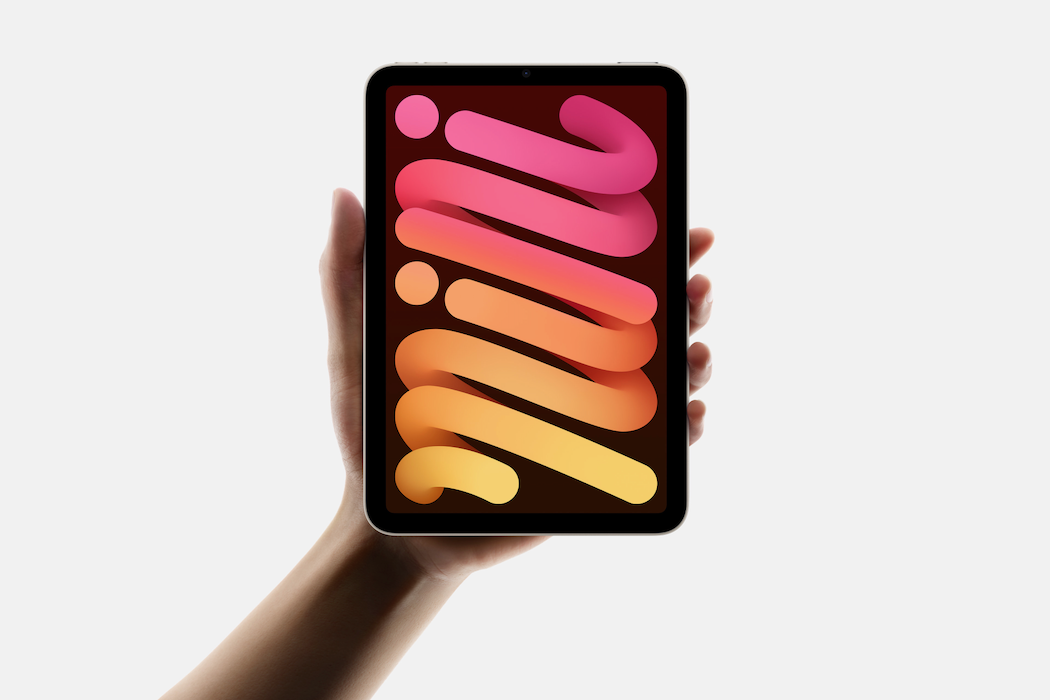
eXtensions - Thursday 17 October 2024
By Graham K. Rogers

This week the new iPad mini 7, plus A17 Pro chip, appeared with no fanfare. Could this mean that the M4 Macs will just be announced by PR releases? Apple Intelligence is coming soon, but not everyone will be able to use the features. Organising images in Photos. TV in the pipeline: AppleTV and Netflix.
Apple gave us an early surprise this week when, with no fanfare and not a hint of a special event, the new iPad mini 7 with an A17 Pro chip was announced. It has support for the Apple Pencil Pro - which will give this iPad some new grown up tricks, and Apple's PR release tells us it is AI ready which has led to some speculation. The iPad mini now starts with a 128GB model, up from the 64GB of version 6. Joe Rossignol (Mac Rumors) also outlines the device and mentions that this has a faster USB-C port (USB-C Gen 2 up to 10Gbps. It also supports WiFi 6E. On the back it now has the inscription, iPad Mini. My version 6 (and before) just have iPad.

I first saw a report on this release, late Tuesday evening here, with a link directly to the press release. It was not until Wednesday over breakfast that tech press reports were available. It is listed in the Apple online Store for Thailand but is not available yet (check back for availability), while the release in the USA is 23 October. Pricing is shown with the basic 128GB WiFi model starting at 17,900 baht. The USA price is $499. At current exchange rates that is 16,500 baht and adding 7% VAT gives 17,655 baht so the pricing is within a reasonable range depending on currency fluctuations.
The release, as well as being a bit of a surprise, was made simply by Apple putting out a press release. Online stores have been updated of course, but this was an unusually quiet release. Ryan Christoffel (9to5Mac) has some basic details speculating that with the way this was released there will be no October event and on the Macs that are predicted writes, "the prospects of an event are looking slim." That is always possible of course, but with devices that are central to Apple's strategy, it would be unusual if we had to rely on the press release and a few YouTube videos. And with Mitchell Broussard (MacRumors) reporting lowest prices on the M3 MacBook Pro, the time for any announcement about M4 Macs (PR release or event) is approaching.

Further to this, other commentators suggest that the likelihood of an Apple Event is less certain now. Taimur Asad (Redmond Pie) outlines the device, but right at the end also suggests that the M4 Mac releases will be by way of press release. Likewise, Ed Hardy (Cult of Mac) also suggests that the press release approach for the iPad mini, lessens the chance that the M4 Macs will be shown at an event. This approach, of course, would save Apple a significant amount of cash.
In a later report (see above), Ryan Christoffel speculates on when Apple will release the next iOS update (and the others), basing this on the 23 October release date for the iPad mini. He notes that despite highlighting the AI capabilities of the device, a short paragraph mentions that the AI features will be coming this month, so will not be included with the iPad mini on its release. As October only has 8 more days after the iPad release, that limits when this might be. That starts with 24 October, although the favorite is the following Monday, the 28th.
With that rollout of Apple's implementation of AI or Apple Intelligence, there will be some strings attached. This may not be as spectacular for some of us as we might hope. Initially, the device region and language need to be set to the United States. Language will not be a problem for me, but if the region is changed I am concerned that time zone and other features may be reset. There will be other languages included in time, although even the favorites, like UK English, will not be seeing AI until December. I appreciate that Apple wants to maintain control to make sure the systems are not overloaded, and non-English speakers do not face problems, but millions of users worldwide will not be able to access some of these new features for a while, if at all.
The chances of these features becoming available here are limited (see comments on Clean Up, below). Already many features available in Siri, and other features such as Fitness are just not available here. With something as controversial as AI, the chances of a Thai rollout are slim. We note also that Apple is aware of potential pitfalls and a 22 page academic article published recently found that, "Our findings reveal that LLMs exhibit noticeable variance when responding to different instantiations of the same question" (Abstract). AI uses pattern matching, not reasoning. And this is a problem that I am finding in academic writing. I am still working through the article, "GSM-Symbolic: Understanding the Limitations of Mathematical Reasoning in Large Language Models." As a large part of my day consists of reading academic output, this is like a busman's holiday.
I am keen to see the new photo-editing feature, Clean Up (if it is available here) which will make it possible to clean up images in new ways in Photos, although I wonder about the ethics. Removing a stranger who wandered into a group photo is fine for the family album or on social networking apps, but for images that are to be used in more formal ways this crosses a line. D. Griffin Jones (9to5Mac) explains the feature, but in his outline of how to access this, he confirms that users will need to turn AI on in Settings then wait for Apple to authorize the user (all the user's devices would be covered). There are likely to be a lot of unhappy users round the world. Europe is out for a start because Apple is not sure how the AI installation will be affected by the legislation there. The rest of us may just have to twiddle our fingers until somehow we are anointed by Apple.

I am averse to some AI use, particularly in academic writing and in photography, although I have seen some good project work on finding problems in X-rays or other types of rapid sorting. With writing I have seen three questionable papers this week alone. With photography, I have had to drop some resistance, for example with the repair tools now available. Essentially, these are not changing the original content of the image, but tidying up what already exists. I do object to sunbeams that are inserted, or water reflections when there is no water in the original.
There have, however, been some good apps that change photographs and produce artistic renditions, such as Waterlogue (it does not use Generative AI) which works full screen on the iPad. It adds an effect to a photograph that make it look like a watercolor painting. I installed this so long ago I forgot what it cost, but an Apple link tells me this is now $5.99. There is also a Mac version that is 1,499 baht here. There was also an iPhone app, Prisma, released in 2016, that produced images after some great artists. Initially free, it used servers in Moscow to apply the effects which were then returned to the user. After a few months it switched to on-device processing. I wondered just how much metadata had been collected by those servers. Despite the beautiful output, I decided to delete the app and it is now available by subscription after 3 days free use. I was also reminded of BeCasso, which was updated this morning. That puts out some reasonable altered images. I especially like that this keeps the metadata.

There has been much criticism of Apple for its high-priced Vision Pro headset, with some commentators seeming to want it to fail so they can have an I-told-you-so moment. There is more to this than some realize: like the Apple Watch that has ended up saving countless people with heart problems, or following accidents; or the iPad, which seemed to start out as a text-based reader but evolved into a multi-faceted device with many strings to its bow: music, video, photography, assistance for the deaf, airline documentation and an all round media device; and of course the iPhone.

In 2016 I tried the Microsoft HoloLens headset at the HIMSS AsiaPac16 conference and exhibition held at the Queen Sirikit Center, Bangkok. At the same event I interviewed Dr Richard Milani who outlined several ways in which the Apple Watch, even then, was helping him monitor patients' health. The HoloLens was intended to be what Vision Pro has become, but the displays back then were not as good as they needed to be and the control - thumb and forefinger, like Vision Pro and the Apple Watch - were not effective in my short look at this. Microsoft, however, clearly had the health industry in its sights.
I have not seen or tried Vision Pro, but the reports I have seen suggest that the clarity of the displays has overcome one of the problems of the HoloLens that I found and there have been early reports of operations in the UK that made use of the device (Thomas Germain, Gizmodo). More recently, William Gallagher (AppleInsider) reports that a surgeon performed a robotically assisted gastric-bypass operation using the Vision Pro.
The image with the article, shows what appear to be two doctors both wearing Vision Pro headsets. "Santiago Horgan [who] heads the Center for the Future of Surgery at UC San Diego" is convinced of the value of the device in surgery. Horgan had "previously tried Microsoft's HoloLens and Google Glass, but says their image resolution was not high enough" [my italics]. Using expensive monitors ($20,000 - 30,000) mounted above, so they have to keep looking up, puts a strain on the backs of surgeons, leading some to retire early. The far cheaper Vision Pro at $3,500 puts the display in front of their eyes, so they no longer put stress on the necks and spines. Not so high-priced after all
I did not think much of the organisation updates to Photos with the iOS 18 update, but when I collected a dozen or so screenshots for a work posting, it occurred to me that I was missing a feature I had used in Aperture frequently, that would be of considerable use: stacking. Some will take several images of the same scene; or a burst shot may produce several photographs that appear identical. In editing, these are sorted, perhaps one or more are culled, but after one of the shots is chosen for use, the rest will be stored. However, within the Library they take up so much space, when all that is needed is a single reference image from which the whole group may be viewed.
An example of this is available in the Finder in a limited way. On the desktop of my Mac, I like to keep a number of reference files that I might need quick access to: documents, PDFs, images, and screenshots. With iCloud I can access these files on all my devices, although these are not stacked on iOS devices. I used this when I was asked to help an academic who was using his Mac to write a book. He was smart when it came to fish, but not Macs. Hundreds of files were just dumped onto the desktop: something like 1500 images as well as other file types. I showed him stacks, but I am not sure if he continued to use them or continued to muddle through.
In the Finder, View menu, the item, Use Stacks sorts the items into groups (stacks). This is only available on the Desktop and not in a Finder window. The user can sort by Kind, or 6 other criteria (4 of which are date types: created, modified, added, last opened). To open a stack, click on the stack and all of the files are available on the Desktop. Now, if I could do that with images in Photos, that would make things a whole lot tidier. I submitted feedback to Apple, but I do not expect much change.

|

|
I was pleased to see that just after the end of Slow Horses, Series 4 when a Series 5 trailer was played, Apple has given a green light to Series 6 (Dennis Sellers, AppleWorld Today). This was expected of course. There is also some pressure (I hope it pays off) to have series 2 and 3 for Bad Monkey. Soon to arrive is Silo, Series 2. Benjamin Mayo (9to5Mac) reports on this and includes a link to a trailer. Over on Netflix there is good and bad, with the news that Kaos is not to be renewed for a second season Nadia Khomami of the Guardian tells us. I found this retelling of the Greek myths rather entertaining, particularly with Jeff Goldblum as Zeus: one of those actors who is always worth watching.
I am currently watching, Monsters, a series about the Menendez brothers who shot their parents, then claimed they were in fear of being killed by them because (they alleged) their father had sexually abused them. The script makes the brothers infuriatingly insincere, although they convinced most of those around them. Especially strong was Episode 6, when Eric was interviewed at the prison by his lawyer and asked to give a full account of the abuse. The lawyer had her back to the camera the whole time so we could only see Eric's face as he convinced her - hesitating at times to tell her all the details. Right at the end, the camera moved in towards his face and we saw his eyes: checking to make sure she had taken the bait. It was a clever piece of direction.
Also worth watching is Bill Nighy, who has appeared in an impressive list of films. He is one of the stars in a 2024 limited release movie that will be available on Netflix on 22 October. It is the story of the development in the 1960s and 70s of in-vitro fertilization which has helped so many childless couples. This saw so much opposition initially, although the comments on Facebook where I first saw the information about the movie were all positive, with many expressing relief. A comment in the trailer made me sit up as the common, male-oriented opinion when the research was being carried out was that this was a problem that affected only a few women. In the 1970s, before IVF was available I knew a couple who were desperate for children but the guy's sperm count was too low. Not so long ago, a married couple I know had problems conceiving but eventually succeeded using IVF. Despite being called names like Doctor Frankenstein, the researchers persevered and thousands of couples are grateful. I have this marked in my Netflix list with a reminder.

Graham K. Rogers teaches at the Faculty of Engineering, Mahidol University in Thailand. He wrote in the Bangkok Post, Database supplement on IT subjects. For the last seven years of Database he wrote a column on Apple and Macs. After 3 years writing a column in the Life supplement, he is now no longer associated with the Bangkok Post. He can be followed on X (@extensions_th). The RSS feed for the articles is http://www.extensions.in.th/ext_link.xml - copy and paste into your feed reader.

For further information, e-mail to
Back to
eXtensions
Back to
Home Page